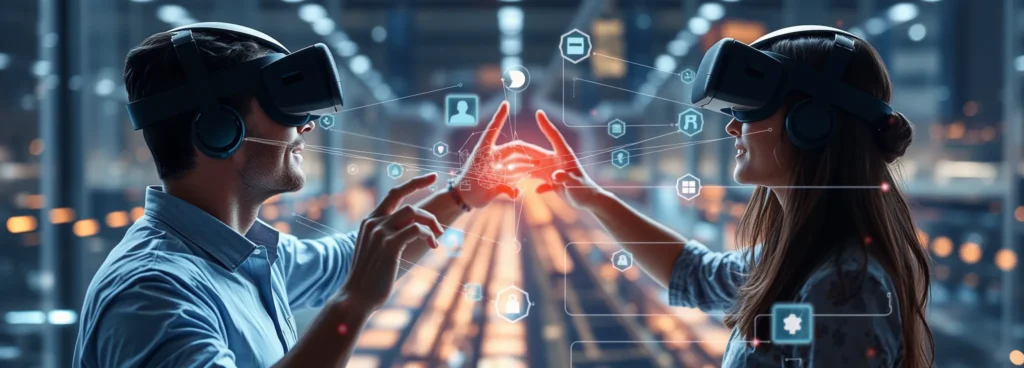
Latency-Free AI: The Role of Edge ML in Augmented and Virtual Reality (AR/VR)
In a world where immersion is everything, even the slightest delay can pull you out of an otherwise magical experience. Imagine exploring an alien planet in virtual reality (VR), and suddenly, your hand motion lags by a second. Or envision using augmented reality (AR) to navigate a busy city street, only for the directions to stutter or freeze. These are the moments that shatter immersion. That’s why eliminating latency is key—and Edge Machine Learning (Edge ML) is rising to the challenge.
What Is Edge ML and Why Does It Matter?
Let’s take a step back: Machine learning (ML) is the foundation of modern AI, allowing systems to learn and improve without being explicitly programmed. But there’s a catch. Most AI models rely on cloud-based servers to process vast amounts of data. That’s great for some tasks, but it’s not ideal when real-time responses are crucial, like in AR/VR environments.
This is where Edge ML shines. Unlike traditional ML, which sends data back and forth to the cloud, Edge ML processes the data locally. This means that instead of waiting for data to travel to a server and back, it’s handled at the source—on your device, at the “edge” of the network. That’s the magic behind reducing latency.
The Relationship Between Latency and Immersion in AR/VR
In the realm of AR/VR, immersion is everything. If you’re using AR glasses, you expect the digital overlay to be seamless with your real-world view. Likewise, in VR, your movements and interactions must feel instantaneous. Even a millisecond of delay can make the experience feel clunky, pulling you out of that digital world. Latency is the enemy of immersion.
Edge ML directly tackles this issue by reducing the time it takes for AI to analyze and act on data. Instead of routing everything through distant servers, decisions happen in real-time. And when AI runs at the edge, you get smooth, fluid, and reactive AR/VR experiences.
How Edge ML Enhances AR Performance
AR is all about layering digital content over the real world. Whether you’re getting directions through an AR map or learning how to repair an engine using AR instructions, you need accuracy and speed. Imagine, for a moment, if those directions appeared too late or lagged as you moved. Frustrating, right? Edge ML helps solve this by processing your real-time data directly on your device.
Take AR glasses for instance. These smart devices use sensors and cameras to constantly scan and map the environment. Instead of sending all that data to the cloud to be processed, Edge ML handles it locally, making interactions much faster and more accurate.
The Role of Edge ML in Virtual Reality

Now think about virtual reality, where you’re entirely inside a digital space. Whether you’re exploring a virtual museum or battling opponents in an immersive game, the AI must react immediately to your actions. In these scenarios, having AI work at the network edge is crucial.
Edge ML helps VR systems provide instant feedback to your movements and interactions. For example, if you raise your virtual sword, the AI needs to react right away. Processing that data on the cloud would introduce too much delay—something that could seriously break immersion. With Edge ML, you get real-time performance without the wait.
Powering Gesture and Voice Recognition with Edge ML
Another area where Edge ML really shines is in gesture and voice recognition. In both AR and VR, you want systems to understand what you’re saying or the gestures you’re making instantly. Imagine a scenario where you’re instructing an AI-powered virtual assistant in VR to pull up a menu, but it takes several seconds for your command to register. Not ideal, right?
With Edge AI in play, voice commands and gestures are interpreted almost instantly. The AI model processes the data locally, allowing for faster responses and smoother interactions, which keeps the experience flowing naturally.
Real-Time Data Processing and the Importance of Speed
When it comes to AR/VR, speed is non-negotiable. The sheer amount of data these systems process—tracking movements, analyzing environments, and updating graphics—means the traditional cloud-based AI just won’t cut it. Edge ML comes in like a knight in shining armor, taking over the heavy lifting.
Think of it like this: when you’re exploring a virtual world, every movement, every twist of your head, every step you take requires immediate feedback. The edge device, equipped with AI capabilities, processes these actions at lightning speed, making your VR adventures feel alive.
Supporting Portable AR/VR Devices with Edge ML
Portability is a huge selling point for AR/VR devices today. Nobody wants to be tethered to a bulky system or dependent on a strong internet connection for immersive experiences. With Edge ML, these devices can operate efficiently without relying on the cloud for real-time data processing.
For instance, AR glasses or lightweight VR headsets benefit massively from Edge ML. It means they can deliver high-quality, immersive experiences without requiring constant access to high-speed internet. This decentralized approach ensures that users can interact with AI even in offline environments, which is game-changing for mobility.
Improving Energy Efficiency with Edge ML
There’s another side to the Edge ML story—energy efficiency. Processing data locally consumes less power compared to constantly sending information to the cloud. This matters because AR/VR devices are often limited by battery life.
By using Edge ML, these systems can save on energy and extend the life of devices during immersive sessions. It’s not just about better performance—it’s about ensuring those high-performance experiences last longer.
Advancing AR/VR Interactions with Edge ML
One of the most exciting aspects of Edge ML in AR/VR is its ability to enhance how users interact with digital environments. In traditional systems, interactions might feel slow or delayed, leading to a less immersive experience. With Edge ML, that barrier vanishes. It powers more natural, intuitive interactions by ensuring your actions are mirrored in real-time within the virtual space.
For example, when you reach out to grab a virtual object in VR, Edge ML processes your movement instantaneously, making the interaction feel seamless. In AR, this could mean adjusting real-time overlays as you walk, without any noticeable lag. These advancements not only heighten immersion but also make AR/VR more accessible to a broader audience by offering smoother, user-friendly experiences.
Edge ML’s Role in Gaming and Entertainment
Gaming and entertainment are major drivers of AR/VR technology, and latency can make or break an experience in this realm. Imagine playing a competitive VR game where you need to react to an opponent’s move, but the system lags, causing you to miss a crucial block or dodge. This delay isn’t just frustrating—it can ruin the entire experience.
By deploying Edge ML within VR gaming environments, the delay is virtually eliminated. Real-time analytics happen at the edge, allowing for split-second decisions, fast-paced action, and smooth gameplay. This doesn’t just benefit players; it also opens up new possibilities for developers to create more intricate, detailed worlds that respond immediately to player inputs.
Edge ML’s Impact on Healthcare Applications in AR/VR
Beyond gaming, healthcare is another sector where AR/VR and Edge ML are revolutionizing processes. From medical training to remote surgeries, speed and precision are critical. Surgeons using AR-assisted glasses need real-time data and visual overlays to guide them through complex procedures. A delay in these visuals could have serious consequences.
With Edge ML, the processing happens close to the user, ensuring that doctors and healthcare professionals get immediate, reliable data. This not only enhances the accuracy of AR/VR tools in medical environments but also increases the overall safety of procedures that rely on AI-powered insights.
The Future of Collaboration in AR/VR with Edge ML
As remote work becomes more common, collaboration tools in AR/VR are gaining traction. Whether it’s brainstorming sessions or detailed project simulations, users rely on a shared virtual environment to interact and communicate. But for effective collaboration, these virtual spaces need to function without a hitch.
Edge ML enables real-time collaboration, making it easier for multiple users to interact in shared AR/VR environments without latency issues. Whether it’s architects collaborating on building designs in VR or teams holding meetings in AR-enhanced spaces, the ability to communicate and interact smoothly is crucial. Edge ML supports these interactions by processing data locally, reducing the risk of delays that could interrupt the flow of ideas.
The Scalability of Edge ML in AR/VR Platforms
Scalability is another crucial factor for the future of AR/VR. As these technologies become more mainstream, the demand for robust systems that can handle heavy traffic grows. Cloud-based solutions often struggle with scaling due to bandwidth and latency issues, but Edge ML offers a way forward.
By handling processing locally, Edge ML can scale without being limited by the traditional constraints of cloud computing. This makes it ideal for large AR/VR environments, such as virtual concerts or massively multiplayer online games (MMOs), where thousands of users interact simultaneously. With Edge ML, these platforms can maintain a high-quality experience for every user, regardless of scale.
Edge ML and the Challenge of Data Privacy in AR/VR
Data privacy is becoming an increasing concern in the age of AI and machine learning. AR/VR devices collect vast amounts of personal data—from eye movements to body gestures—and when this data is sent to the cloud, it becomes vulnerable. Edge ML offers a solution by processing this sensitive data locally on the device.
By keeping the data at the edge, users can have greater control over their information, reducing the risk of breaches and improving overall privacy. This is particularly important for enterprise AR/VR applications, where proprietary or sensitive information must remain secure.
The Next Steps for Latency-Free AR/VR Experiences
As Edge ML continues to evolve, the possibilities for latency-free AR/VR are endless. We are on the cusp of creating virtual environments that are so seamless, so instantaneous, that they feel like an extension of reality itself. This opens the door to new industries and applications, from virtual tourism to education, where immersive learning environments react in real-time to student inputs.
Moreover, the development of 5G networks will further boost Edge ML‘s potential in AR/VR, enabling faster data transfer rates and improving the overall quality of these immersive experiences.
Overcoming Challenges in Implementing Edge ML for AR/VR
While the benefits of Edge ML in AR/VR are clear, there are still challenges to overcome. The main hurdle lies in the hardware capabilities of current AR/VR devices. Processing complex machine learning models at the edge requires significant computational power, and not all devices are equipped to handle this yet.
However, as hardware continues to improve, and as AI models become more efficient, the barriers will begin to break down. The future looks bright for Edge ML in AR/VR, especially as developers continue to push the boundaries of what’s possible.
Closing the Gap Between Reality and Virtual Worlds
Edge ML isn’t just about reducing latency—it’s about closing the gap between our physical world and the digital environments we create. In the coming years, AR and VR experiences will feel even more natural, immersive, and engaging, thanks to the continuous advancements in edge computing. The fusion of these technologies will shape the future of how we interact with the digital and physical worlds alike, bringing us closer to the truly latency-free AI-driven experiences we’ve long imagined.
By leveraging Edge ML, the dream of seamless, latency-free AR/VR is becoming a reality. The technology holds the potential to not only transform how we play, learn, and work in these digital spaces but also to redefine our expectations of real-time interaction and immersive environments.
FAQ:
What is Edge ML?
Edge Machine Learning (Edge ML) is a form of AI where data processing happens locally on a device rather than in the cloud. This means that instead of sending data back and forth to cloud-based servers, everything is analyzed and processed at the “edge” of the network—closer to the user’s device. This greatly reduces latency, allowing for faster and more responsive AI interactions.
How does Edge ML reduce latency in AR/VR?
In AR/VR, every movement or interaction generates data that needs to be processed. If this data is sent to a cloud server, it introduces a delay, or latency, as it travels back and forth. Edge ML processes the data on the device itself, which means there’s no need to wait for the cloud, leading to almost instantaneous reactions, essential for immersive experiences.
Why is latency such a big issue in AR/VR?
Latency directly affects the quality of immersion in AR/VR. If the system delays your movements or commands, it can disrupt the experience, causing frustration and even motion sickness in some users. Smooth, real-time responses are critical to maintaining immersion in virtual environments, and that’s why reducing latency is so important.
How does Edge ML enhance gaming in VR?
In VR gaming, quick reactions and seamless interactions are crucial for a great experience. By utilizing Edge ML, data is processed in real-time, allowing for faster decision-making and smoother gameplay. It ensures that players’ movements are mirrored instantly within the game, providing a more fluid and competitive environment.
Can Edge ML improve AR glasses performance?
Yes! AR glasses rely on constantly mapping and analyzing real-world environments to overlay digital content accurately. Edge ML allows this data to be processed immediately on the device, making AR interactions, like navigation or instructions, faster and more responsive, enhancing the overall user experience.
What are some applications of Edge ML in healthcare AR/VR?
Edge ML is revolutionizing healthcare by supporting real-time, immersive applications such as AR-assisted surgeries and virtual training simulations. Doctors can use AR glasses to get real-time guidance during procedures, while medical students can practice in VR environments where feedback is instant and accurate, enhancing learning and patient safety.
Does Edge ML improve privacy in AR/VR?
Yes. By processing data locally on the device rather than sending it to the cloud, Edge ML improves data privacy and security. This means that sensitive data, such as user movements, gestures, or voice commands, stays on the device, reducing the risk of breaches or leaks, which is particularly important in enterprise or healthcare settings.
How does Edge ML help with collaboration in AR/VR?
Edge ML enables real-time collaboration in AR/VR environments by allowing multiple users to interact seamlessly without delays. This is particularly useful for remote work, where teams can meet in virtual spaces, share ideas, and work on projects together in real time, improving productivity and communication.
Is Edge ML scalable for larger AR/VR environments?
Absolutely! Edge ML allows AR/VR systems to scale more efficiently than cloud-based systems because it processes data locally, reducing bandwidth requirements. This makes it possible to create larger, more complex virtual environments, like massive multiplayer online games (MMOs) or virtual events, without compromising performance or user experience.
What challenges exist in implementing Edge ML for AR/VR?
One of the primary challenges is the hardware limitations of current AR/VR devices. Processing complex AI models at the edge requires powerful computing resources, which not all devices currently have. However, as hardware evolves and AI models become more efficient, these limitations are expected to decrease over time.
How does Edge ML impact energy efficiency in AR/VR devices?
Edge ML improves the energy efficiency of AR/VR devices by processing data locally, reducing the need for constant communication with cloud servers. This helps save power, which is critical for portable AR/VR devices that rely on battery life for extended use.
How will 5G networks enhance the role of Edge ML in AR/VR?
The rollout of 5G will significantly boost the capabilities of Edge ML by enabling faster data transfer rates and lower network latency. This means even quicker responses and smoother experiences in AR/VR, especially in complex, multi-user environments where high bandwidth and real-time interactions are crucial.
What industries will benefit most from Edge ML in AR/VR?
While gaming and entertainment are obvious beneficiaries, industries such as healthcare, education, manufacturing, and retail are also set to gain from the application of Edge ML in AR/VR. These sectors rely on real-time feedback, precise interactions, and seamless user experiences, all of which Edge ML can deliver.
Is Edge ML the future of AR/VR?
Absolutely. As the demand for faster, more immersive, and real-time experiences grows, Edge ML will become increasingly critical in shaping the future of AR/VR. It promises to bring us closer to truly latency-free, highly interactive, and deeply immersive digital environments.
Resources for Learning More About Edge ML and AR/VR
To dive deeper into Edge Machine Learning and its impact on Augmented Reality (AR) and Virtual Reality (VR), check out these helpful resources. Whether you’re a beginner or someone with a solid understanding of the technology, these materials will guide you through the latest trends, research, and practical applications.
Books and eBooks
- “Edge AI: Convergence of Edge Computing and Artificial Intelligence” by Xiaofei Wang, Min Chen, and others
This comprehensive book explores how edge computing and AI combine to create more responsive systems in various applications, including AR/VR. - “Learning Augmented Reality and Virtual Reality: 50 Projects to Hone Your Skills” by Micheal Miller
A practical guide for those who want hands-on experience with AR and VR technologies. It includes beginner-to-advanced projects, touching on ML integration in AR/VR.
Online Courses
- Coursera: “Edge Computing for the Internet of Things”
This course introduces the concept of Edge Computing, diving into how it’s used with IoT and AI applications, including those in AR/VR. You’ll learn about latency reduction and real-time data processing. Find the course here on Coursera - Udemy: “Augmented Reality & Machine Learning: Building Next-Gen AR Apps”
Learn to develop AR applications with integrated ML models that run on edge devices, providing hands-on experience with Edge AI. Find the course here on Udemy
Research Papers and Journals
- “Edge Intelligence: Paving the Last Mile of Artificial Intelligence with Edge Computing”
This research paper provides a deep dive into Edge Intelligence, the marriage of AI and edge computing. It covers how this technology applies to real-time AR/VR experiences. - “Towards Latency-Free AR/VR Systems with Edge Computing”
Published in IEEE journals, this paper investigates the latency challenges in AR/VR systems and how Edge Computing mitigates them. Search for the paper on IEEE Xplore
Industry Blogs and Articles
- NVIDIA Blog: “How Edge AI is Transforming Augmented and Virtual Reality”
This blog from NVIDIA discusses how advancements in edge technology are pushing the boundaries of AR/VR, providing real-world examples and use cases. - Edge AI and Vision Alliance Blog: “The Importance of Edge AI in Virtual Reality”
This blog explores the intersection of Edge AI and VR, detailing how they are creating faster, more immersive experiences.
Developer Resources and Platforms
- TensorFlow Lite
TensorFlow Lite is a popular framework for deploying ML models on mobile and edge devices. It’s an excellent resource for developers looking to integrate Edge ML into their AR/VR projects. Explore TensorFlow Lite - ARCore and ARKit Developer Docs
Google’s ARCore and Apple’s ARKit are essential platforms for creating AR experiences. Both platforms support ML integration, which is critical for Edge AI-powered AR apps.- ARCore Docs
- ARKit Docs
Community Forums and Discussion Boards
- Reddit – r/MachineLearning
A highly active community where professionals and enthusiasts discuss the latest trends in Machine Learning, including its applications in Edge Computing and AR/VR.
Visit r/MachineLearning - AR/VR on Stack Overflow
For technical questions about AR/VR development, this Stack Overflow community is a fantastic resource where developers share solutions and insights on integrating Edge ML into AR/VR platforms.
Visit Stack Overflow





